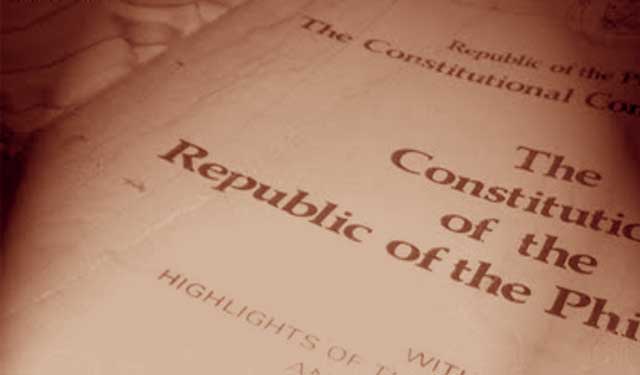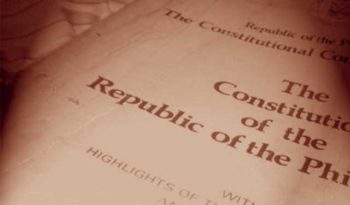
Are you for a FEDERAL SYSTEM of Government?
 Most of us would not give an immediate response since the topic on federalism is unfamiliar. Since changing our system of government is a serious matter, we are invited to take time to look into it.
Most of us would not give an immediate response since the topic on federalism is unfamiliar. Since changing our system of government is a serious matter, we are invited to take time to look into it.
What is a Federal System of Government?
It is a system that divides up power between a strong national government and smaller local governments called states or regions.
How is it different from what we have now?
At present we have a presidential form of government with a unitary system of governance. Most administrative power and resources are with the national government based in Manila. It is Malacaῇang that decides how much to give local government units (LGUs). How to spend the budget, LGUs need national approval. The national government can take back their given authority unilaterally at any time. Under federalism, it can only be withdrawn by constitutional amendment.
Note: Form of gov’t differs from system of gov’t.
Forms/types of gov’t: Presidential, Parliamentary, Semi-Presidential
Systems of gov’t: Unitary, Federal
Why shift to a federal system of government?
The main reason is to make the government bring equitable development across the country by sharing political and economic powers with regions and LGUs. The complaint is that the power given by the unitary system to LGUs is so little that they have failed to realize their fullest development as self-reliant communities, but it has created an “Imperial Manila.” Regarding finance, their share in the revenue from tax collection is fixed at 60-40% in favor of the central gov’t. And an added complaint is the age-old conflicts and secessionist movements in Mindanao that continue to defy solution.
What makes a Federal System?
It has these common characteristics:
- Two levels of gov’t: federal or central and regions or constituent units
- A written constitution with clear division of powers that can only be amended by mutual consent of federal gov’t and constituent units
- Regional representation at the federal gov’t
- A final arbiter or umpire to resolve constitutional disputes (Constitutional Court)
- A mechanism or body to facilitate cooperation between and among federal and regional gov’t
How did federal countries emerge?
They emerged in different circumstances; each is unique but generally born this way:
- Formerly separate regions came together (USA-1789, Switzerland-1848, Australia-1901, Malaysia-1946)
- Formerly a unitary country decided to federalize due to demands for decentralization (Mexico-1824, Argentina-1853, Brazil-1899, Spain-1978, Belgium-1993, South Africa-1997)
- A combination of the two processes (Canada-1867, India-1950)
How do we reconfigure our country under a federal system?
Decide the number and boundaries of regions.
New boundaries may follow the traditional boundaries of administrative or political units. Or, divisions can be based on census data with the following criteria:
- Economic and financial capacity
- Ethnic, language or cultural grouping
- History of being part of an administrative unit
- Proximity of provinces forming a region
- Cooperation among local gov’t leaders
Some proponents and proposals:
Nene Pimentel = 11 states & 1 Federal
Administrative Region (Manila) Form: Federal-presidential
Congress:
Senate – 75 senators (6 from each state + 9 elected by OFWs)
House of Representative: 350 members
Rep. Aurelio Gonzales = 18 regions
Form: Federal-presidential
Congress: 2 to 6 senators per region
House of Rep.: one per district with party-list representative (20% of total members)
Regional Assembly: 3 from each province, city, sectors (labor groups and senior citizens)
PDP-Laban = 11 regions
Form: Federal-semi-presidential with dual executive (president & prime minister)
Bicameral Parliament:
-Federal Assembly (60% from districts +40% party-list representatives)
-Senate (6 senators per region)
Note: Every form and system of government has its own advantages and disadvantages. And a survey of the federal systems in the world shows variety and absence of any one model. From a newly published book by Ateneo de Manila University (Debate on Federal Philippines, A Citizen’s Handbook by Eduardo Araral, Jr. et al), the following questions are answered:
What are the conditions for federalism to succeed?
“Without these reforms, the shift to federalism is bound to fail… 1) constitutional restrictions on political dynasties; 2) shift to a dual executive or semi-presidential form of government; 3) banning of political butterflies; 4) strengthening of political parties; 5) shift to proportional representation; 6) strengthening of constitutional bodies in the regions particularly the commissions on civil service and audit; 7) reducing the duplication of work between the Senate and House of Representatives; and 8) judicial reforms including strengthening of the Sandiganbayan, appellate courts, and Ombudsman at the regional level. This package of reforms suggests that tinkering with the Local Government Code alone to transfer more powers to the regions would not be sufficient.”
What basic principles to consider before embarking on a process of political reform?
1st – Study and understand pre-existing conditions of the country. In doing so, major problems to be addressed are first identified, followed by working out the solutions (problem-driven process of political reform). This is in contrast to the flawed solution-driven process, in which one proposes first a solution and then works backwards to justify the chosen solution. The disadvantages of this process were stated in the forum cynically titled “If Federal-ism is the Answer, What is the Question?” (UP School of Economics, Sept 2016)
2nd – Understand the nature and capacity of our present political institutions – especially the bureaucracy and political parties. For example, if the deficiencies of our unitary system are actually caused by an inefficient bureaucracy and weak political parties, shifting to federalism means building on the same weak foundation. So the frustrations experienced under the unitary system would just be replaced by a new set of frustrations and disappointments ushered in by federalism.
3rd – Anticipate unintended consequences; the bigger the reform package, the bigger the risk. The shift from a unitary to a federal system and from presidential to semi-presidential form of gov’t – done simultaneously – is a major reform and quite risky. This is not to say NO to political reforms, but to emphasize the importance of foreseeing the risks of unintended consequences.
These risks were echoed by former Chief Justice Hilario Davide when he was invited in Makati to speak on federalism (21 Nov. 2017). His speech, published in Manila Bulletin in three parts, is titled: Shift to federalism: A lethal experiment, a fatal leap, a plunge to death, a leap to hell. First of all he said that the 1987 Constitution is being amended via the shortest mode (Constituent Assembly instead of a Constitutional Convention) and expected to be submitted for ratification as the Constitution of the Federal Republic of the Philippines in May 2018.
For him the main motive for shifting to federal-ism could be answered by the 1987 Constitution, Article X – Local Government and the 1991 Local Government Code. The power sharing between the central government and the LGUs is assured and mandated by the Constitution, not impeded. On the contrary, it is the failure to implement the provisions of the Constitution for the needed local decentralization. In conclusion he enumerated the risks of federalism like a bloated bureaucracy that would require higher taxes, provide wider opportunities for political dynasties and corruption.
More than a change in gov’t system is the needed change in one’s heart and values, even as we pray the Holy Spirit to enlighten our Constituent Assembly. May our Blessed Mother, our country’s patroness, guide all of us. (Sr. Monina Baybay, fsp)


No Comments